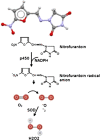Nitrofurantoin: properties and potential in treatment of urinary tract infection: a narrative review
- PMID: 37577377
- PMCID: PMC10414118
- DOI: 10.3389/fcimb.2023.1148603
Nitrofurantoin: properties and potential in treatment of urinary tract infection: a narrative review
Abstract
Nitrofurantoin (NF), a wide-spectrum antibiotic accessible since 1953, is utilized widely to treat urinary tract infections as it usually stays active against drug-resistant uropathogen. The use of Nitrofurantoin has increased exponentially since new guidelines have repositioned it as first-line therapy for uncomplicated lower urinary tract infection (UTI). To, although fluoroquinolones are usually used to re-evaluate the first- and second-line therapies for treating uncomplicated UTI, their level of utilization is thought to be inappropriately excessive and will eventually have a detrimental impact; thus, we hypothesize that NF might be the best choice for this condition, because of its low frequency of utilization and its high susceptibility in common UTI pathogens. It can be concluded from this review that NF can be considered as the most effective drug in the treatment of acute urinary infection, but due to the long-term side effects of this drug, especially in elderly patients, it is essential to introduce some criteria for prescribing NF in cases of chronic UTI.
Keywords: Nitrofurantoin; drug-resistant uropathogen; fluoroquinolones; side effects; urinary tract infection.
Copyright © 2023 Mahdizade Ari, Dashtbin, Ghasemi, Shahroodian, kiani, Bafandeh, Darbandi, Ghanavati and Darbandi.
Conflict of interest statement
The authors declare that the research was conducted in the absence of any commercial or financial relationships that could be construed as a potential conflict of interest.
Figures



References
-
- Abd A. H., Abd M. H., Obed F. A. (2014). Efficacy of combination of nitrofurantoin with gentamicin, and ciprofloxacin against resistant E. Coli isolated from patients with urinary tract infections: in vitro study. Mintage J. Pharm. Med. Sci. 3 (2), 5–9.
-
- Al-safi S. M., fadhil hasson Al-Shabaa K., AL-Zeiny S. S., Al-Dhalimy A. M. (2020). Synergistic and antimicrobial effects of leaves oil (phoenix dactylifera) agonist gram negative bacteria. System. Rev. Pharm. 11 (11), 177–181.
-
- Andriole V. T. (1985). “Urinary tract agents: quinolones, nitrofurantoin, and methenamine,” in Principles and practice of infectious diseases (New York: John Wiley and Sons; ), 244–253.
Publication types
MeSH terms
Substances
LinkOut - more resources
Full Text Sources
Medical

